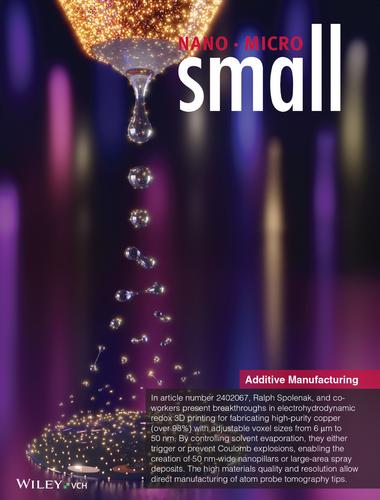关于电流体动力氧化还原三维打印的分辨率极限(小号 46/2024)
IF 13
2区 材料科学
Q1 CHEMISTRY, MULTIDISCIPLINARY
引用次数: 0
摘要
Additive Manufacturing在文章编号 2402067 中,Ralph Spolenak 及其合作者介绍了电流体动力氧化还原三维打印技术的突破性进展,该技术用于制造高纯度铜(98% 以上),其体素尺寸可从 6 μm 调整到 50 nm。通过控制溶剂蒸发,它们可以触发或阻止库仑爆炸,从而制造出 50 纳米宽的纳米柱或大面积喷射沉积物。由于材料质量高、分辨率高,因此可以直接制造原子探针断层成像尖端。本文章由计算机程序翻译,如有差异,请以英文原文为准。

On the Resolution Limit of Electrohydrodynamic Redox 3D Printing (Small 46/2024)
Additive Manufacturing
In article number 2402067, Ralph Spolenak, and co-workers present breakthroughs in electrohydrodynamic redox 3D printing for fabricating high-purity copper (over 98%) with adjustable voxel sizes from 6 μm to 50 nm. By controlling solvent evaporation, they either trigger or prevent Coulomb explosions, enabling the creation of 50 nm-wide nanopillars or large-area spray deposits. The high materials quality and resolution allow direct manufacturing of atom probe tomography tips.
求助全文
通过发布文献求助,成功后即可免费获取论文全文。
去求助
来源期刊

Small
工程技术-材料科学:综合
CiteScore
17.70
自引率
3.80%
发文量
1830
审稿时长
2.1 months
期刊介绍:
Small serves as an exceptional platform for both experimental and theoretical studies in fundamental and applied interdisciplinary research at the nano- and microscale. The journal offers a compelling mix of peer-reviewed Research Articles, Reviews, Perspectives, and Comments.
With a remarkable 2022 Journal Impact Factor of 13.3 (Journal Citation Reports from Clarivate Analytics, 2023), Small remains among the top multidisciplinary journals, covering a wide range of topics at the interface of materials science, chemistry, physics, engineering, medicine, and biology.
Small's readership includes biochemists, biologists, biomedical scientists, chemists, engineers, information technologists, materials scientists, physicists, and theoreticians alike.
 求助内容:
求助内容: 应助结果提醒方式:
应助结果提醒方式:


